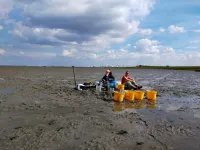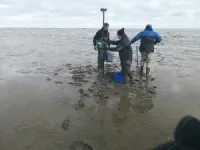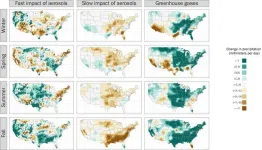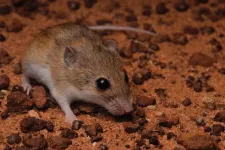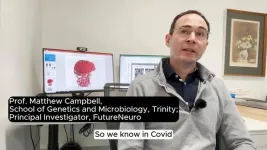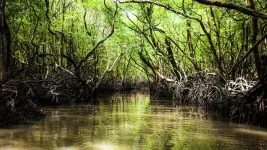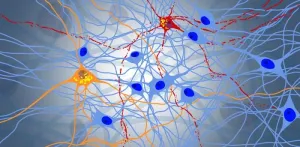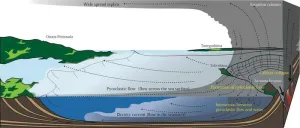(Press-News.org) If storms become stronger in the future due to climate change, more nitrogen may be released from the bottom of coastal seas. This is shown by research of marine biogeochemist Dunia Rios-Yunes at NIOZ in Yerseke. Rios-Yunes will defend her PhD-thesis today at the University of Utrecht. “The dynamics of nutrients in deltas and estuaries have been a bit of a blind spot for marine science, so far”, she says.
Inflatable couch
For her experiments, Rios-Yunes spent many hours on an inflatable couch on the dry bottom of the Wester- and the Oosterschelde. “I mimicked a storm on the mud, using a bucket without a bottom and a big blender, stirring up the mud and measuring the release or the uptake of nitrogen and phosphorous. But, since I needed to do this for six hours in a row, I rapidly found out that I needed a little bit of comfort, sitting on the mud. The inflatable couch was my life saver during the field work”, she jokingly says.
More N, less P
Rios-Yunes found out that considerable amounts of nitrogen are released when her experimental storm stirs the bottom. “In just a couple of hours, the amount of nitrogen that is normally released in weeks, may come out of the mud during one storm. This means that much more nutrients become available in the water column, and these could be used algae to grow.” Phosphorous, on the other hand, was taken up during the ‘storm’ in the Oosterschelde but released in the Westerschelde. “This may be because of the differences in chemical composition of the mud between an estuary and a tidal bay.”
Ecosystem services
Storage of nutrients like nitrogen and phosphorous, but also of many trace elements, are considered a crucial ecosystem service of places like the Wester- and the Oosterschelde. This ecosystem service is under increasing pressure, Rios-Yunes explains. For example, the Oosterschelde coast is relatively important for storage of nutrients, compared to the subtidal sea bottom. But due to the Oosterschelde storm surge barrier and also with rising sea levels in the future, the coast of the Oosterschelde is ‘eaten by the currents’. “Therefore, relatively large amounts of nutrients may become available for algae and other organisms.”
Equilibria
Temperature and salinity, as well as benthic animals also influence the chemistry of the tidal sea floor. “But these phenomena have not been studied a lot, so far”, Rios-Yunes says. “For fundamental research into the dynamics of nutrients and other equilibria in tidal areas, it is very important to understand the role of temperature, salinity, benthic animals and also turmoil by storms.”
Coastal squeeze
Polici makers and keepers of natural areas like the Oosterschelde should also understand the dynamics of nutrients in a changing world, Rios-Yunes says. “My research stresses the importance to keep the coast of these tidal areas in a good condition, and thus avoid losing the valuable ecosystem services they provide.”
About NIOZ Sea Research
The Royal Netherlands Institute for Sea Research (or NIOZ Sea Research), is the national oceanographic institute and the Netherlands’ centre of expertise for ocean, sea, coast and delta. We advance fundamental understanding of marine systems, the way they change, the role they play in climate and biodiversity, and how they may provide sustainable solutions to society in the future.
END
Stronger storms free more nutrients from mud flats
Stronger storms free more nutrients from mud flats
2024-02-22
ELSE PRESS RELEASES FROM THIS DATE:
New study is first step in predicting carbon emissions in agriculture
2024-02-22
MINNEAPOLIS / ST. PAUL (02/19/2024)—For the first time, researchers at the University of Minnesota Twin Cities (UMN) and the University of Illinois Urbana-Champaign (UIUC) have demonstrated that it is possible to provide accurate, high-resolution predictions of carbon cycles in agroecosystems, which could help mitigate the impacts of climate change.
The study by scholars from the UMN-led National Artificial Intelligence Institute for Climate-Land Interactions, Mitigation, Adaptation, Tradeoffs and Economy (AI-CLIMATE) and UIUC-led Agroecosystem Sustainability ...
Air pollution hides increases in rainfall
2024-02-22
We know that greenhouse gas emissions like carbon dioxide should increase rainfall. The emissions heat the atmosphere, causing a one-two punch: warmer oceans make it easier for water to evaporate, and warmer air can hold more water vapor, meaning more moisture is available to fall as rain. But for much of the 20th century, that increase in precipitation didn’t clearly show up in the data.
A new study led by researchers at the Department of Energy’s Lawrence Berkeley National Laboratory (Berkeley ...
Damage to cell membranes causes cell aging
2024-02-22
Our cells are surrounded by a fragile membrane that’s only 5 nanometers thick, 1/20 of a soap bubble. Cells are easily damaged by physiological activities, including muscle contraction and tissue injury. To cope with such damage, cells are equipped with mechanisms that can repair membrane damage to a certain degree.
Mechanical damage to the cell membrane was previously believed to trigger two simple cellular outcomes: recovery or death. In this study, however, the researchers uncovered a third outcome – cellular senescence.
“When I started this project, I simply aimed to understand ...
Mice surprise: Australian researchers discover new native species
2024-02-22
Australia can lay claim to two new species of native rodent thanks to a study from The Australian National University (ANU).
The aptly named delicate mouse was previously thought to be a single species spanning a massive stretch of the country from the Pilbara in Western Australia, across parts of the Northern Territory and through Queensland down to the New South Wales border.
But researchers at ANU and CSIRO thought there might be more to the story.
Lead author Dr Emily Roycroft, from ANU, said we now know there ...
Latest research redefines neurodevelopmental risks, outcomes for congenital heart disease
2024-02-22
Statement Highlights:
A new American Heart Association scientific statement updates more than a decade of research identifying, managing and preventing neurodevelopmental delays and disorders among people with congenital heart disease.
The new statement outlines important changes since the Association’s last statement in 2012, such as revised criteria to determine which children and adults are at high risk for neurological developmental delays and disorders, as well as an updated list of factors that may increase the risk.
Critical next ...
Researchers discover underlying cause of “brain fog” linked with Long COVID
2024-02-22
Today, a team of scientists from Trinity College Dublin and investigators from FutureNeuro announced a major discovery that has profound importance for our understanding of brain fog and cognitive decline seen in some patients with Long COVID.
In the months after the emergence of the novel coronavirus SARS-CoV2 in late 2019 a patient-reported syndrome termed Long-COVID began to come to the fore as an enduring manifestation of acute infection.
Long COVID has up to 200 reported symptoms to date, but in general patients report lingering symptoms such as fatigue, ...
Carbon emissions from the destruction of mangrove forests predicted to increase by 50,000% by the end of the century
2024-02-22
The annual rate of carbon emissions due to the degradation of carbon stocks in mangrove forests is predicted to rise by nearly 50,000% by the end of the century, according to a new study published in IOP Publishing’s journal Environmental Research Letters. Mangroves in regions such as southern India, southeastern China, Singapore and eastern Australia are particularly affected.
Mangrove forests store a large amount of carbon, particularly in their soils, however human development in these areas has led to the degradation of these carbon ...
Cracking the code of neurodegeneration: New model identifies potential therapeutic target
2024-02-22
Scientists at the University of Zurich have developed an innovative neural cell culture model, shedding light on the intricate mechanisms underlying neurodegeneration. Their research pinpointed a misbehaving protein as a promising therapeutic target in the treatment of amyotrophic lateral sclerosis (ALS) and frontotemporal dementia (FTD).
Neurodegenerative diseases cause some of the neurons in our brains to die, resulting in different symptoms depending on the brain region affected. In amyotrophic lateral sclerosis (ALS), neurons in the motor cortex and spinal ...
Former Dutch minister and renowned gastroenterologist joins NTU Singapore as Vice President of Research
2024-02-22
Nanyang Technological University, Singapore (NTU Singapore) has appointed Professor Ernst Kuipers, a renowned gastroenterologist, healthcare executive, and former Minister of Health, Welfare and Sport for The Netherlands, as NTU Singapore’s new Vice President (Research).
Prof Kuipers will also be appointed to the tenured faculty rank of Distinguished University Professor, the highest faculty rank at NTU bestowed upon faculty members with extraordinary scholarly achievements that typically span multiple disciplinary boundaries.
Announcing this new appointment, NTU President Prof Ho Teck Hua said: “We warmly welcome ...
Biggest Holocene volcano eruption found by seabed survey
2024-02-22
A detailed survey of the volcanic underwater deposits around the Kikai caldera in Japan clarified the deposition mechanisms as well as the event’s magnitude. As a result, the Kobe University research team found that the event 7,300 years ago was the largest volcanic eruption in the Holocene by far.
In addition to lava, volcanos eject large amounts of pumice, ashes and gases as a fast-moving flow, known as “pyroclastic flow,” and its sediments are a valuable data source on past eruptions. For volcanoes on land, geologists understand the sedimentation mechanism of pyroclastic flows well, but the sediments themselves get lost easily ...
LAST 30 PRESS RELEASES:
Eye for trouble: Automated counting for chromosome issues under the microscope
The vast majority of US rivers lack any protections from human activities, new research finds
Ultrasound-responsive in situ antigen "nanocatchers" open a new paradigm for personalized tumor immunotherapy
Environmental “superbugs” in our rivers and soils: new one health review warns of growing antimicrobial resistance crisis
Triple threat in greenhouse farming: how heavy metals, microplastics, and antibiotic resistance genes unite to challenge sustainable food production
Earthworms turn manure into a powerful tool against antibiotic resistance
AI turns water into an early warning network for hidden biological pollutants
Hidden hotspots on “green” plastics: biodegradable and conventional plastics shape very different antibiotic resistance risks in river microbiomes
Engineered biochar enzyme system clears toxic phenolic acids and restores pepper seed germination in continuous cropping soils
Retail therapy fail? Online shopping linked to stress, says study
How well-meaning allies can increase stress for marginalized people
Commercially viable biomanufacturing: designer yeast turns sugar into lucrative chemical 3-HP
Control valve discovered in gut’s plumbing system
George Mason University leads phase 2 clinical trial for pill to help maintain weight loss after GLP-1s
Hop to it: research from Shedd Aquarium tracks conch movement to set new conservation guidance
Weight loss drugs and bariatric surgery improve the body’s fat ‘balance:’ study
The Age of Fishes began with mass death
TB harnesses part of immune defense system to cause infection
Important new source of oxidation in the atmosphere found
A tug-of-war explains a decades-old question about how bacteria swim
Strengthened immune defense against cancer
Engineering the development of the pancreas
The Journal of Nuclear Medicine ahead-of-print tip sheet: Jan. 9, 2026
Mount Sinai researchers help create largest immune cell atlas of bone marrow in multiple myeloma patients
Why it is so hard to get started on an unpleasant task: Scientists identify a “motivation brake”
Body composition changes after bariatric surgery or treatment with GLP-1 receptor agonists
Targeted regulation of abortion providers laws and pregnancies conceived through fertility treatment
Press registration is now open for the 2026 ACMG Annual Clinical Genetics Meeting
Understanding sex-based differences and the role of bone morphogenetic protein signaling in Alzheimer’s disease
Breakthrough in thin-film electrolytes pushes solid oxide fuel cells forward
[Press-News.org] Stronger storms free more nutrients from mud flatsStronger storms free more nutrients from mud flats
